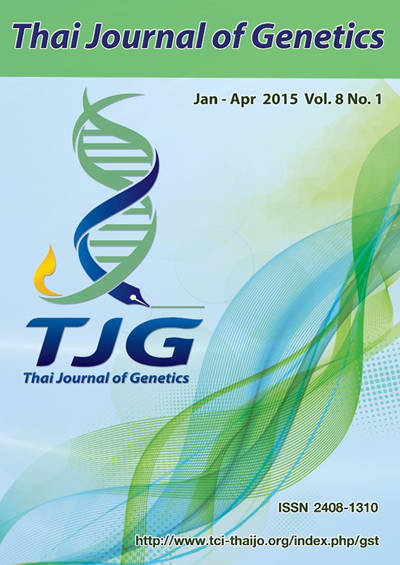Application of KaryoLite™ BACs on Beads™ assay for prenatal diagnosis to detect chromosome aneuploidy in amniotic fluid cells
DOI:
https://doi.org/10.14456/tjg.2015.1Keywords:
prenatal diagnosis, KaryoLite™ BACs on Beads™, conventional karyotyping, amniotic fluid cellAbstract
Prenatal diagnosis (PND) is a technique to detect chromosome abnormalities in fetus before birth. The techniques currently used for PND are conventional karyotyping and fluorescent in situ hybridization (FISH). Both techniques still have limitations, e.g., a high error rate of detection. The purpose of this study was to evaluate the efficiency of KaryoLite BACs-on-Beads (KL-BoBs™) as a routine diagnostic assay in a clinical application for PND by comparison with conventional karyotyping. A total of 37 amniotic fluid cell samples from 18 patients were used to validate KL-BoBs™ technique. The results of the KL-BoBs™ were 100% concordant with karyotyping for trisomy 18, trisomy 21, triple X, normal XX and normal XY. In conclusion, our results indicated that KL-BoBs™ had high concordance with conventional karyotying for prenatal diagnosis to detect chromosome status in amniotic fluid cells. Moreover, using an appropriate reference could reduce the coefficient of variation (CV) and increase accuracy of interpretation.
References
Baart EB, Martini E, Eijkemans MJ, Van Opstal D, Beckers NGM, Verhoeff A, Macklon NS, Fauser BC (2007) Milder ovarian stimulation for in-vitro fertilization reduces aneuploidy in the human preimplantation embryo: a randomized controlled trial. Hum Reprod 22: 980–988.
Baxter L, Adayapalam N (2013) A comparative study of standard cytogenetic evaluation and molecular karyotyping for products of conception: Diagn Mol Pathol 22: 228–235.
Carp H, Toder V, Aviram A, Daniely M, Mashiach S, Barkai G (2001) Karyotype of the abortus in recurrent miscarriage. Fertil Steril 75: 678–682.
Grati FR, Gomes DM, Ganesamoorthy D, Marcato L, De Toffol S, Blondeel E, Malvestiti F, Loeuillet L, Ruggeri AM, Wainer R, et al. (2013) Application of a new molecular technique for the genetic evaluation of products of conception: KaryoLiteTM BoBsTM for genetic analysis of products of conception. Prenat Diagn 33: 32–41.
Harton GL, Magli MC, Lundin K, Montag M, Lemmen J, Harper JC (2010) ESHRE PGD Consortium/ Embryology Special Interest Group--best practice guidelines for polar body and embryo biopsy for preimplantation genetic diagnosis/screening (PGD/PGS). Hum Reprod 26: 41–46.
Magli MC, Gianaroli L, Ferraretti AP, Lappi M, Ruberti A, Farfalli V (2007) Embryo morphology and development are dependent on the chromosomal complement. Fertil Steril 87: 534–541.
Menasha J, Levy B, Hirschhorn K, Kardon NB (2005) Incidence and spectrum of chromosome abnormalities in spontaneous abortions: new insights from a 12-year study. Genet Med 7: 251–263.
Paxton CN, Brothman AR, Geiersbach KB (2013) Rapid aneusomy detection in products of conception using the KaryoLiteTM BACs-on-BeadsTM assay: KL-BoBsTM aneusomy detection in POCs. Prenat Diagn 33: 25–31.
Robberecht C, Schuddinck V, Fryns J-P, Vermeesch JR (2009) Diagnosis of miscarriages by molecular karyotyping: benefits and pitfalls. Genet Med 11: 646–654.
Sheath KL, Duffy L, Asquith P, Love DR, George AM (2013) Bacterial artificial chromosomes (BACs)-on-BeadsTM as a diagnostic platform for the rapid aneuploidy screening of products of conception. Mol Med Rep 8: 650–654.


